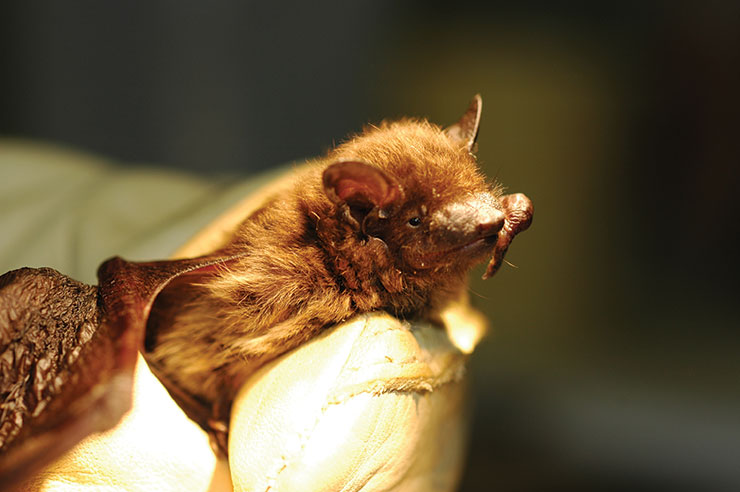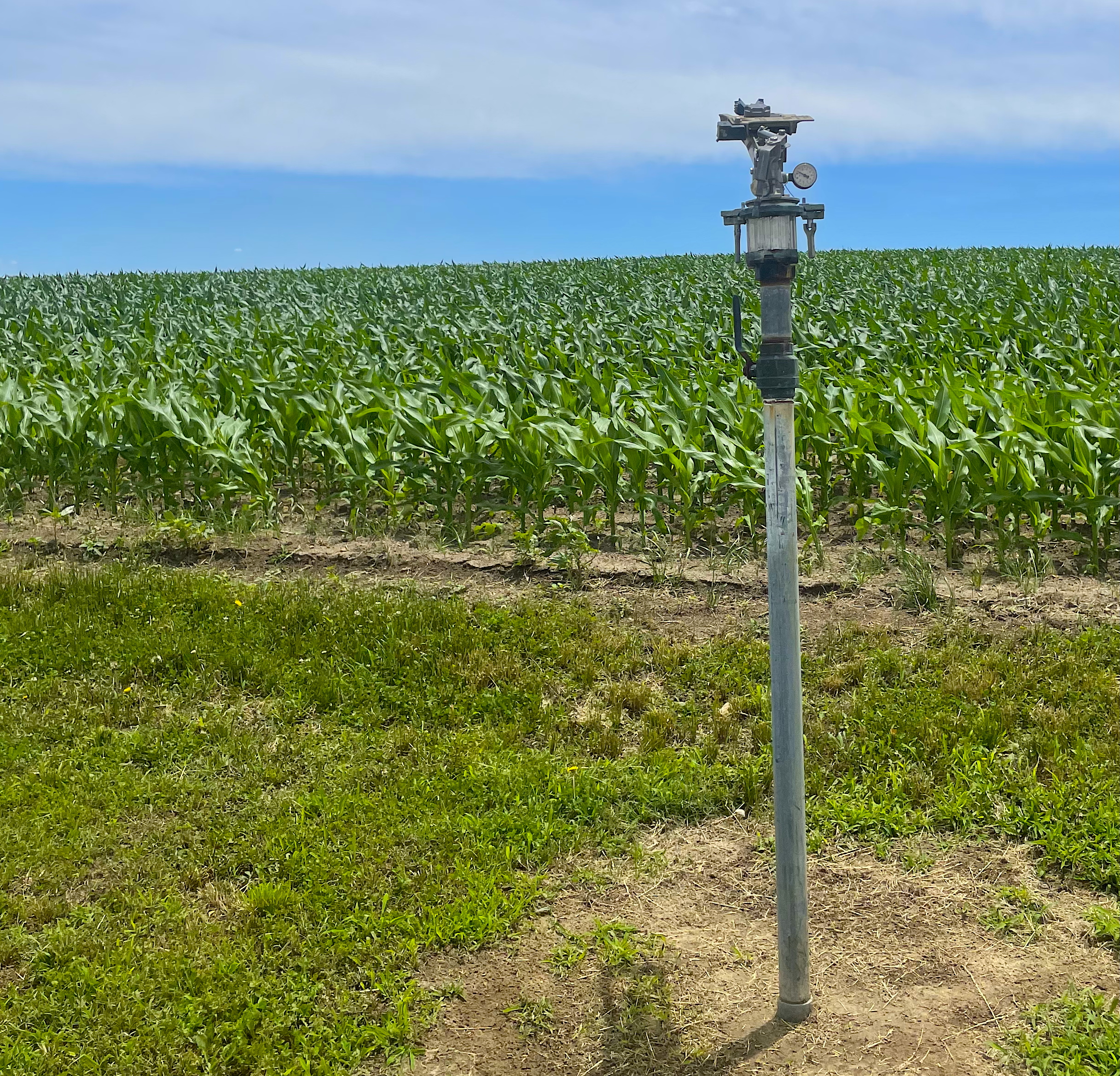The Bat Barometer

When it comes to environmental change, Mother Nature’s creatures are often the best bellwethers. The bald eagle opened our eyes to the dangers of pesticides. Giant pandas show us the cost of habitat loss and deforestation. The plight of the polar bears heralds rising temperatures for the earth. Usually, it is these bioindicators — the rare, the exotic and the remote — that make headlines.
But there are plenty of barometers of environmental health in our own backyards. New research out of the University of North Carolina at Greensboro (UNCG) reveals that bats can help us gauge the condition of urban rivers and streams.
“Bats are an integral part of the environment, and they are associated with streams worldwide,” says Matina Kalcounis-Rueppell, a biologist at UNCG and the lead researcher on the study.

With funding help from North Carolina Sea Grant’s minigrant program, Kalcounis-Rueppell and a team of three students spent the summers of 2005 and 2006 searching for feeding bats along North and South Buffalo creeks, near the headwaters of the Cape Fear River. Each creek is home to a wastewater treatment plant, making the water bodies two of the most polluted in the state, according to the North Carolina Department of Environment and Natural Resources. The Cape Fear runs into the Atlantic, south of Wilmington.
The researchers discovered wastewater discharge affected the presence of certain insects, which influenced the feeding habits of two common bat species. These results suggest the effects of wastewater discharge are felt at higher levels of the food web, according to Kalcounis-Rueppell.
“It is important to understand how interconnected everything is,” notes Victoria Payne, one of the student researchers.
Michael Voiland, executive director of North Carolina Sea Grant, agrees.
“Coastal watersheds are complex ecosystems, and we are still learning how our actions upstream affect the larger food web,” he says. “This research provides us with new clues about such an intricate puzzle.”
TRACING THE FOOD WEB
There are more than 1,100 bat species on earth. Many of these species prey on insects and forage along streams. A single bat can consume hundreds of insects per evening. These winged mammals keep mosquitoes from overtaking suburbia, and also eat the moths of crop-destroying caterpillars and tree-boring beetles that decimate forests. Although extensive research on bat diet exists, few studies have examined diet with respect to water quality. Kalcounis-Rueppell’s study is the first in North America to address the question, and the results were published in the May 2007 issue of Biological Conservation, a leading scientific journal in wildlife and conservation biology.

North and South Buffalo creeks provided an easy prey/predator structure for researchers to trace how pollution discharged from specific point, or a “point-source,” persisted through the food web.
Several insect species live in streams and emerge at night, Kalcounis-Rueppell explains. Bats are the major predators of those bugs, putting bats at the top of that food chain.
Previous research by colleagues at UNCG’s stream ecology lab revealed that wastewater-derived nitrogen was found in the larvae of aquatic insects downstream of a wastewater treatment plant.
“It was logical for me to ask — what about the animals that eat these insects once they come out of the water?” Kalcounis-Rueppell explains. “Thus, bats are terrestrial animals that have potential to show a response to water quality.”
Treated sewage from wastewater treatment plants contain organic matter, toxins and nutrients such as phosphate and nitrate, explains Gloria Putnam, water quality planning specialist for North Carolina Sea Grant.
Such discharge can change the feeding behaviors of aquatic insects, adds Dave Penrose, a water quality biologist in North Carolina State University’s biological and agricultural engineering department.
“Aquatic insects are a very common monitoring tool to assess water quality,” Penrose says, noting that the state has “reams” of data on the subject.
But both he and Putnam admit that looking at bats as indicators of water quality is a new concept.
“It’s fantastic though,” Putnam says. “We need to see how far into the food web these pollutants are affecting ecosystems.”
BUG BUFFET
Kalcounis-Rueppell’s first major find was a difference in the insect community structure and abundance upstream versus downstream from the treatment plants.

“So it’s not just what insects are present, but how many there are,” she explains.
Upstream the team found more beetles, flies and moths, whereas more damselflies and dragonflies were present downstream.
“That result is interesting in and of itself,” Kalcounis-Rueppell says, because many of those insects are terrestrial. That means the discharge not only affected the presence of aquatic insects, as expected, but also those insects further into the ecosystem.
The three most common bat species in the watershed also showed a response to the increases of these bugs. Eastern pipistrelles, known to feast on aquatic insects, were consistently found foraging downstream of the nutrient-rich discharge.
“They were feeding non-stop,” Kalcounis-Rueppell says.
Upstream, on the other hand, the researchers found more big brown bats. One of the most common species found in North Carolina’s Piedmont region, big browns are “generalists,” meaning they eat both terrestrial and aquatic insects.
Meanwhile, evening bats, another generalist species, showed no difference in their feeding or activity upstream or downstream from the wastewater treatment plants.
“We’re seeing a bat species-specific effect,” Kalcounis-Rueppell says. “This is pretty exciting because it’s the first North American example of bats clearly being impacted by water quality.”
Two similar studies on bats and water quality were conducted in the United Kingdom during the 1990s with mixed results. One correlative study found no difference in bat foraging behavior over polluted streams versus those with low nutrient levels. In contrast, another study similar to Kalcounis-Rueppell’s found that certain bat species were more common upstream from an effluent discharge site, others more common downstream, and for some species it made no difference.
FEEDING? OR FLYING?
To make sure bats were congregating above or below the treatment plants to forage — and not for another reason, such as roosting habitat — Kalcounis-Rueppell and her team measured both flying and feeding behavior.

Beginning in May, the team sampled sites upstream and downstream of both treatment plants three to six times per week, from sunset to sunrise. Their equipment was a marriage of laboratory tools and fishing gear — digital mp3 recorders, tiny plastic test tubes, tweezers, calipers, nets, hip waders and lanterns.
To capture emergent aquatic insects, the team stretched mesh tents over the creek. For terrestrial insects, researchers placed a funnel-shaped net, called a “malaise” trap, in the vegetation near the stream edge. In the nearby trees were ultrasonic bat detectors attached to voice-activated digital recorders.
“With our automated equipment, I can tell whether bats are actually feeding in an area or whether they are just flying through,” Kalcounis-Rueppell says.
Bats must echolocate to navigate their environment and find food. To echolocate, a bat produces a high-frequency pulse from its throat, well beyond the range of the human ear. When that pulse bounces off an object and back to the bat’s ears, it can determine the location of the object.
The digital recorders picked up those pulses, and the team later slowed down the calls and analyzed them in the laboratory using specialized software. A chirping noise at a constant interval indicated a bat was simply flying through a site. When that chirping noise sped up, it meant a bat had locked in on an insect.
“Once a bat detects something, it has to start emitting those sounds more quickly because it actually has to hone in on it,” Kalcounis-Rueppell explains. This pattern is known as a “feeding buzz.”
Researchers then determined the species by comparing the recordings to a known library of bat calls housed at UNCG.
“So we know when a particular species was at a certain site, and we know if they were feeding or just flying through,” Kalcounis-Rueppell says. “At the same time, we were collecting insects at the given site, and we also caught bats at the site to determine their diet.”
WAITING GAME
Catching the bats was trickier than the insects, Payne says. To intercept bats, the team strung up a large net across the creek. Next, they donned hip waders, heavy gloves and some patience.
“We had to check those nets every 10 to 15 minutes because the bats can chew their way out,” Payne recalls. “Some nights we were lucky to get one bat in the net all night. Other times we spent the whole night trying to get bats out.”

After wading into the river to untangle a bat, the researchers recorded measurements and determined the species. Then, they placed the bat into a small cotton bag and waited for the best source of diet information — excrement. Most hard-bodied insects are difficult for bats to chew, Kalcounis-Rueppell explains.
“We just placed the turds in ethanol and waited for the pieces to fall apart,” she says.
From the bits of eyes, wings, legs, scales and antennae left behind, researchers could identify the insects consumed. But this method contained some biases, Kalcounis-Rueppell admits.
“Bats don’t only eat hard-bodied insects,” she explains, adding that many emergent aquatic insects, such as mayflies, are soft-bodied. “We won’t find them because they get digested.”
For her next round of research, Kalcounis-Rueppell is searching for funding to continue her study using a stable isotope method. This involves examining the ratio between nitrogen and carbon, two stable elements, from hair clipped from a bat’s back. These ratios will help determine not only what the bats are eating, but also where they are feeding along the stream.
The ratio of nitrogen and carbon in the aquatic vegetation differs upstream versus downstream from the treatment plants because of the nutrient-rich discharge, she explains.
Therefore, the element ratios also will differ in the insects feeding on these plants, and in bat feeding on the insects.
“The isotope work will give us a much clearer picture of what happens up and downstream,” Kalcounis-Rueppell says.
And for something as complex as food web dynamics and ecosystem health, even a little bit of clarity can go a long way, Voiland adds.
“This minigrant generated new knowledge about how the human imprint can impact an ecosystem,” he says. “Even though minigrants are small fiscal investments, they often can add to, or even shake up, contemporary understanding of how our coastal resource works.”
********************************************************************************************************************************
BATS OF NORTH CAROLINA
From the Blue Ridge mountains to coastal barrier islands, North Carolina is home to several bat species. The most common species across the state are the eastern pipistrelle, the big brown bat and the red bat. The rarest bats include southeastern myotis and Indiana myotis, Townsend’s big-eared bat and Rafinesque’s big-eared bat. Townsend’s big eared bats only occur in the mountains, and are endangered.
- Big brown bat (Eptesicus foscus fuscus)
- Brazilian free-tailed bat (Tadarida brasiliensis)
- Eastern pipistrelle (Pipistrellus subflavus subflavus)
- Eastern red bat (Lasiurus borealis borealis)
- Eastern small-footed myotis (Myotis leibii)
- Evening bat (Nycticeius humeralis humeralis)
- Hoary bat (Lasiurus cinereus cinereus)
- Indiana myotis (Myotis sodalis)
- Little brown myotis (Myotis lucifugus lucifugus)
- Northern myotis (Myotis septentrionalis)
- Rafinesque’s eastern big-eared bat (Corynorhinus rafinesquii rafinesquii)
- Seminole bat (Lasiurus seminolus)
- Silver-haired bat (Lasionycteris noctivagans)
- Southeastern myotis (Myotis austroriparius austroriparius)
- Townsend’s (western) big-eared bat (Corynorhinus townsendii virginianus)
Source: N.C. Museum of Natural Sciences
********************************************************************************************************************************
BEYOND THE HAUNTED HOUSE
Ugly, dirty, and rabid.
Matina Kalcounis-Rueppell has heard it all, and probably worse. A bat biologist at the University of North Carolina at Greensboro, she is accustomed to defending these tiny mammals as more than just haunted house ambiance. Here she shares some facts — and deconstructs some myths — about her beloved study subjects.
Conservation
- Nearly one out of every four species of mammal on earth is a bat. Of the 5,400 known mammal species, more than 1,100 are bats.
- Bats are the most rapidly declining land mammals in the North America.
- The majority of bat species inhabit tropical regions, but 47 species are found in the United States and Canada. Seven species are commonly found in North Carolina’s Piedmont.
Biology
- Bats are the only mammals that can fly. Technically, flying squirrels glide.
- Bats belong to their own Order, Chiroptera, which translates to “hand wing” in Greek.
- The bones in a bat’s wing are almost identical to a human hand, but a bat’s fingers are longer and joined with skin for flight.
- Bats can hang upside down without expending any energy because of special adaptations in their legs and feet. Compared to a human being, a bat’s knees face backwards, and specialized tendons in its toes help it cling to roosts.
- Bats fall into one of two categories: fruit and nectar eaters or insect eaters. All bats found in North Carolina eat insects.
- Vampire bats are the only species of bat that eat blood. Found in Latin America, these bats make small cuts on larger animals, such as cattle, and lap up the dripping blood.
- Bats are very clean animals and groom themselves constantly.
Reproduction
- In North America, female bats mate in the fall and self-fertilize in the spring. Females give birth to one or two young, or pups, early in the summer.
- Male bats are more solitary creatures. Bat colonies are largely made up of females and nursing pups.
- Cooperation is common among mother bats. In some species, some females remain with the pups in the roost while others hunt for food. After feeding at night, a mother bat nurses her pup all day.
- Pups grow fast, and midway through the summer they begin to fly and hunt for themselves. In the fall, bats either hibernate or head south for warmer climates.
***********************************************************************************************************************************
BACKYARD BAT HOUSES
In the backyard battle of pest control there are no stronger allies than bats.
Bat houses are becoming increasingly common in American backyards as people search for natural, safe methods to ward off mosquitoes and other pests. Although people may be skeptical about recruiting bats to live nearby, these critters quickly prove to be good neighbors.
What About Rabies?
The rabies virus in humans is rare in the United States, according to the Centers for Disease Control and Prevention (CDC). Usually there are only one to two human cases per year. Most bats do not have rabies, the CDC reports, and those that do contract the virus tend to die quickly afterwards.
The best way to prevent rabies is to have your pets vaccinated, because they are more likely to come in contact with wild animals. Still, never try to handle a bat. If you find a bat lying on the ground, leave it alone and contact a local animal control or public health agency immediately.
Buy or Build?
If you choose to buy a bat house, be a discriminating consumer. Many commercially sold bat houses are not properly designed or constructed to attract North American bat species. Such houses may also lack instructions for proper placement, sun exposure and mounting. When purchasing a bat house, check to see if it is “Bat Approved” by Bat Conservation International (BCI), a non-profit organization that carries out research on bats and bat houses, at www.batcon.org.
If you choose to build a bat house, you can find detailed instructions online from BCI. All you’ll need are a few tools, some wood, and a free afternoon. You also can join the ranks of “citizen scientists” and be part of the BCI bat house research project.
This article was published in the Autumn 2007 issue of Coastwatch.
For contact information and reprint requests, visit ncseagrant.ncsu.edu/coastwatch/contact/.


